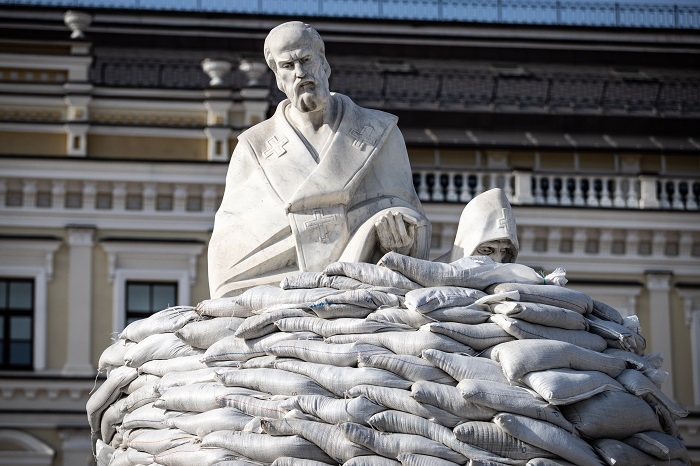ISABEL RUBIO ARROYO | Tungsteno
Russian bombs in Ukraine have brought down hundreds of structures and utilities, as well as destroying thousands of kilometres of roads. Since the invasion began on 24 February, the United Nations Educational, Scientific and Cultural Organisation (UNESCO) has verified damage to 62 religious sites, 12 museums, 43 historical or cultural buildings, 15 monuments and nearly a dozen libraries.
As the Russian invasion continues, Ukraine is stepping up efforts to protect its cultural heritage. In fact, despite the ongoing conflict, the country has already begun preparations for the reconstruction of cities, communities and infrastructure destroyed by the Russians. This was announced by the country's president, Volodymyr Zelensky, who stressed that the main objective is to restore normal life to all the territory that the Russian occupiers have entered and where the missiles have hit.
One of the big challenges for Europe, according to the International Monetary Fund, will be to rebuild Ukraine and its economy in a way that encourages the return of refugees: "Rebuilding destroyed infrastructure will require extensive financing with a significant grant element." In addition to Ukraine having allocated UAH 1.4 billion—about EUR 44 million—to restore critical infrastructure in five regions, it has received support from the UK, Denmark, Japan, Italy, Romania and other countries to join in the restoration of the affected territories. "We want not just to rebuild, but we want and will make better and more modern everything that was destroyed by Russian barbarians. It also means that there will be a major transformation of the Ukrainian economy after the war. We must build a new Ukraine together with you," said Ukrainian Prime Minister Denys Shmyhal. So far, the reconstruction and clearing of some roads, the restoration of the electrical power supply and the demining of lands are already underway.
Churches damaged and windows shattered
Among the emblematic sites that have been affected by the conflict are a number of religious buildings, for example St Catherine's Orthodox Church in Chernihiv, a historic city in northern Ukraine. This structure, striking for its five golden domes, was damaged in a rocket attack in March, according to the US public broadcasting service NPR. "They hit the church just before mass," explained Father Mykolai, who showed fragments of shrapnel collected from among the broken cobblestones outside. Some Ukrainian soldiers were supposedly guarding a nearby crossroads, but the attack did not affect them. "They said the church saved them," Mykolai said.
Among the more than 60 religious structures damaged, according to UNESCO, are also some churches in the Kyiv region, such as the Cathedral of the Resurrection of Christ, and in other regions such as Kharkiv, for example the Church of the Holy Queen Tamara, and Donetsk.
In Donetsk, the Cathedral of Saint Michael the Archangel in Mariupol, for example, has been damaged. After weeks of incessant Russian bombardment, the crowning dome of this Orthodox cathedral was torn off and is now a mangled heap of shattered steel and smashed brickwork, according to the BBC. As well as the glass windows being shattered, holes remain in the red brick walls.

As the Russian invasion continues, Ukraine steps up efforts to protect its cultural heritage. Credit: Wikimedia Commons.
Theatres, museums and libraries reduced to rubble
In addition to churches, damage and destruction has also rained down on theatres, museums, libraries and monuments. On 16 March, Russia bombed the Mariupol Drama Theatre, where hundreds of civilians were sheltering. Although some survived, a total of some 600 people were killed, according to an investigation by the Associated Press. The stone building, built with white pillars and a red roof, stood in the heart of Mariupol for 60 years and had been arranged as a bomb shelter because of its size, the strength of its walls and its large basement. Although the theatre's set designer painted the word "children" twice on the ground in large white letters in the hope of avoiding air raids, Russian bombing left the building reduced to rubble.
Up to 600 people were killed in the Russian attack on the Mariupol theatre. Credit: Associated Press.
Also damaged are the Korolenko Chernihiv Regional Universal Scientific Library in Donetsk, the Chernihiv Regional Art Museum and the Palaces of Culture of Mariupol and Lozova. The latter building, located in Kharkiv province, was destroyed by a missile strike in May. "The occupiers identified culture, education and humanity as their enemies. And they do not spare either missiles or bombs. What is in the minds of the people who choose such targets? Absolute evil," Zelensky said after the attack.
Some monuments have also been damaged by the Russian air force. These include a memorial to Afghan soldiers in Kiev and the Drobytsky Yar Holocaust Memorial outside the city of Kharkiv. This is a memorial to the thousands of local Jews who perished during World War II. "The Nazis have returned. Exactly 80 years later," the Ukrainian Ministry of Defence posted on Twitter on 26 March.

Russian air forces have also damaged a monument at the entrance to the Drobytsky Yar memorial complex. Credit: Ukrainian Ministry of Defence.
"We are very concerned about both the situation at the humanitarian and heritage levels. Humanity’s heritage is in danger [in Ukraine]," said Ernesto Ottone, UNESCO's Assistant Director General for Culture. Beyond the emblematic sites cited, much other infrastructure has been destroyed or damaged, according to Ukrainian President Volodymyr Zelensky: more than 32 million square metres of living space, more than 1,500 educational facilities, more than 350 medical facilities, some 2,500 kilometres of roads and nearly 300 bridges. While the invasion is inflicting infrastructure damage valued at $4.5 billion a week, according to the Kyiv School of Economics, Ukraine claims to have begun rebuilding cities and infrastructure.
· — —
Tungsteno is a journalism laboratory to scan the essence of innovation. Devised by Materia Publicaciones Científicas for Sacyr’s blog.
